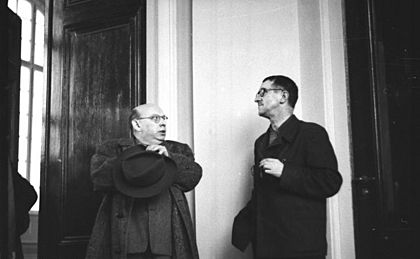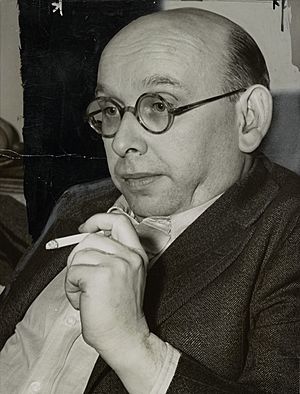Hanns Eisler facts for kids
Hanns Eisler (born July 6, 1898 – died September 6, 1962) was an Austrian composer. He is famous for writing the national anthem of East Germany. He also worked closely with the writer Bertolt Brecht for many years. Eisler wrote music for many films too. The Hochschule für Musik Hanns Eisler Berlin music school is named after him.
Contents
Family and Early Life
Hanns Eisler was born in Leipzig, Germany. His father, Rudolf Eisler, was a philosophy professor. His mother was Marie Ida Fischer. In 1901, his family moved to Vienna, Austria.
Hanns had two siblings who were also involved in politics. His brother, Gerhart, was a journalist. His sister, Elfriede (known as Ruth Fischer), was a leader in the German Communist Party. Later, when she moved to America, she spoke out against her brothers.
When Hanns was 14, he joined a socialist youth group. This group believed in fairness for all people.
Music and Working with Bertolt Brecht
During World War I, Hanns Eisler was a soldier for Austria-Hungary. He was hurt several times. After the war, he studied music in Vienna from 1919 to 1923. His teacher was Arnold Schoenberg, a famous composer. Eisler was one of the first students to use Schoenberg's "twelve-tone" music style. This style uses all 12 notes of the musical scale equally.
In 1925, Eisler moved to Berlin, Germany. Berlin was a very exciting place for new ideas in music, theater, and art. There, he supported the Communist Party of Germany. His music started to focus on political ideas. It also became more "popular" and used sounds from jazz and cabaret music.
Around this time, he became good friends with Bertolt Brecht. Brecht was a writer who also became interested in Marxism, a political idea about society. Eisler and Brecht worked together for the rest of Brecht's life.
In 1929, Eisler wrote a song series called Zeitungsausschnitte. The songs were like newspaper headlines. They talked about the hard lives of ordinary Germans after World War I.
Eisler wrote music for many of Brecht's plays. These included The Decision (1930) and The Mother (1932). They also created protest songs together. Their song "Solidarity Song" became a popular anthem. It was sung in street protests across Europe. These songs often showed life from the view of unemployed or poor people. In 1931–32, they worked on a film about working-class life called Kuhle Wampe.
Life in Exile
After 1933, the Nazi Party banned Eisler's music and Brecht's writings. Both artists had to leave Germany. Brecht went to Denmark. Eisler traveled to many countries, including Prague, Paris, London, and Moscow. He visited the United States twice.
In 1938, Eisler finally moved to the United States. He taught music in New York City. In 1942, he moved to Los Angeles. There, he joined Brecht, who had also arrived in California.
In the U.S., Eisler wrote music for many documentary films. He also composed music for eight Hollywood movies. Two of these, Hangmen Also Die! and None but the Lonely Heart, were nominated for Oscars. Bertolt Brecht also worked on Hangmen Also Die!. Film music became a very important part of Eisler's work.
In 1940, Eisler started a project about music and films. This led to a book called Composing for the Films, published in 1947.
During this time, Eisler also returned to the "twelve-tone" music style. His piece Fourteen Ways of Describing the Rain is considered a masterpiece. He also wrote a large choral symphony called Deutsche Sinfonie (1935–57). Another important work was the Hollywood Songbook (1938–43). This collection of songs made him known as a great composer of German lieder (art songs).
Investigation in the U.S.
Eisler's career in the U.S. was stopped by the Cold War. He was one of the first artists put on the Hollywood blacklist. This meant film studios would not hire him.
He was questioned by the House Un-American Activities Committee (HUAC). This committee investigated people suspected of being communists. Eisler was accused of being "the Karl Marx of music" and a Soviet agent. His own sister, Ruth Fischer, spoke against him and his brother Gerhart to the committee.
Many famous people supported Eisler. These included his friend Charlie Chaplin and composers like Igor Stravinsky and Leonard Bernstein. They held concerts to raise money for his legal defense. But in early 1948, Eisler was forced to leave the U.S. The folk singer Woody Guthrie wrote a song called "Eisler on the Go" to protest this.
On March 26, 1948, Eisler and his wife, Lou, flew to Prague.
Life in East Germany

Eisler first returned to Austria, then moved to East Berlin in East Germany. There, he composed the national anthem of East Germany, called "Auferstanden aus Ruinen". He also wrote songs for theater, films, and TV.
His biggest project was an opera called Johannes Faustus. Eisler wrote the story himself. It showed the character Faust as someone who did not support the working class. In 1953, the government newspaper criticized his opera. They said it showed Faust in a bad way and was "a slap in the face of German national feeling." Because of this criticism, Eisler became very sad and did not write the music for the opera.
In his last work, "Ernste Gesänge" (Serious Songs), Eisler tried to deal with his sadness. He continued to compose and teach music. He also became friends with musician Wolf Biermann.
Eisler worked with Brecht until Brecht's death in 1956. Eisler never fully recovered from losing his friend. He died of a heart attack in East Berlin in September 1962. He is buried near Brecht in the Dorotheenstadt cemetery.
Compositions
- 1918: Gesang des Abgeschiedenen ("Die Mausefalle")
- 1919: Drei Lieder
- 1922: Allegro moderato and Waltzes; Allegretto and Andante for Piano
- 1923: Piano Sonata No. 1, Op. 1
- 1923: Divertimento for wind quintet, Op. 4
- 1924: Piano Sonata No. 2, Op. 6
- 1925: Eight Piano Pieces
- 1926: Tagebuch des Hanns Eisler (Diary of Hanns Eisler); 11 Zeitungsausschnitte
- 1928: "Drum sag der SPD ade"; "Lied der roten Matrosen" ("Song of the Red Sailors")
- Between 1929 and 1931: "Solidaritätslied"
- 1929: Tempo der Zeit (Tempo of Time) for chorus and small orchestra, Op. 16
- 1930: Die Maßnahme (The Measures Taken, text by Bertolt Brecht), Op. 20
- 1931: Incidental music for Die Mutter (The Mother) by Bertolt Brecht
- 1931: Film music for Kuhle Wampe (texts by Brecht)
- 1932: Kleine Sinfonie (Little Symphony); Suite No. 4, Music for the Russian film Pesn' o geroyakh (Song of Heroes)
- 1934: "Einheitsfrontlied" ("United Front Song")
- 1935: Die Mutter (The Mother) rewritten as cantata
- 1935: Lenin Requiem for solo voices, chorus and orchestra
- 1937: Seven cantatas based on texts from Ignazio Silone's novels
- 1938: String Quartet
- 1940: Music for the documentary film White Flood
- 1941: Music for the documentary film A Child went forth
- 1940/41: Film music for The Forgotten Village
- 1941: Woodbury-Liederbüchlein (20 children songs); "14 Arten den Regen zu beschreiben" (14 ways to describe rain)
- 1942: "Hollywood-Elegien" ("Hollywood Elegies"; with Brecht) in the Hollywooder Liederbuch (Hollywood Songbook)
- 1943: Film music for Hangmen Also Die!; Piano Sonata No. 3
- 1945: Film score for The Spanish Main
- 1946: Songs and ballad for Brecht's play Life of Galileo.
- 1947: Septet No. 2
- 1947: Music for The Woman on the Beach
- 1949: Auferstanden aus Ruinen (National Anthem of the DDR)
- 1950: Neue deutsche Volkslieder, collection of songs
- 1955: Night and Fog, music for the film
- 1957: Sturm-Suite für Orchester
- 1935–1958: Deutsche Sinfonie (after texts of Bertolt Brecht and Ignazio Silone)
- 1962: "Ernste Gesänge" ("Serious Songs")
Writings
- A Rebel in Music: selected writings. New York: International Publishers, 1978
See also
 In Spanish: Hanns Eisler para niños
In Spanish: Hanns Eisler para niños




